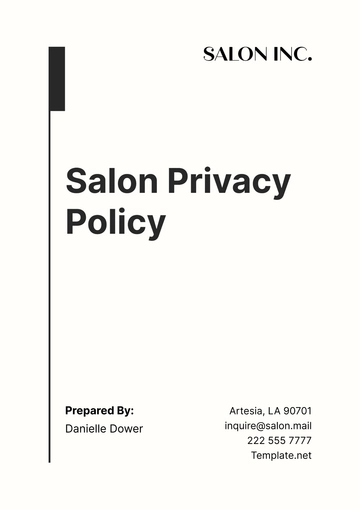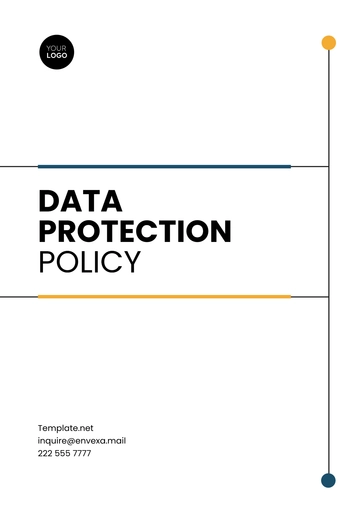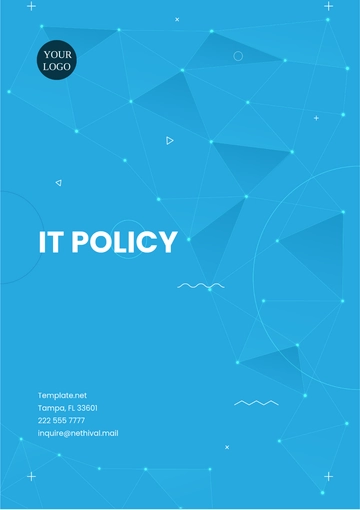Free Marketing Market Policy & Procedure

1. Introduction
In today's hyper-competitive business environment, where consumer preferences and market dynamics shift at breakneck speed, marketing plays a pivotal role in shaping the success of [Your Company Name]. This section introduces the importance of a well-defined marketing strategy and sets the stage for the subsequent sections of this document.
Welcome to the Marketing Market Policy & Procedure document for [Your Company Name]. In a world characterized by rapid technological advancements and constantly evolving consumer behaviors, the role of marketing has become more vital than ever. Effective marketing not only drives sales but also builds brand equity, fosters customer loyalty, and positions our company as a leader in our industry.
2. Executive Summary
The Executive Summary condenses the key components and objectives of this document into a concise overview.
This Executive Summary provides a snapshot of the Marketing Market Policy & Procedure document, highlighting its core purpose, mission, vision, and the key sections that follow. This document serves as a blueprint for our marketing strategies, ensuring they are not only effective but also ethical, compliant, and aligned with our brand's mission and vision.
3. Purpose
The purpose of this section is to articulate the rationale behind the Marketing Market Policy & Procedure. It aims to provide a clear sense of direction for all marketing activities undertaken by [Your Company Name]. By offering detailed guidelines, assigning responsibilities, and defining processes, we ensure that our marketing initiatives are not just effective but also ethical and compliant.
4. Mission Statement
At [Your Company Name], our mission in the marketing arena is to be a force for transformation. We aspire to deliver innovative and sustainable marketing solutions that resonate deeply with our audience, forging meaningful connections and leaving a positive imprint on the market and the world.
5. Vision Statement
Our vision is to ascend to the zenith of the marketing realm, renowned for our steadfast commitment to excellence, ethics, and sustainability. We envisage a market landscape where businesses thrive by adopting purpose-driven marketing strategies that not only bolster their bottom lines but also contribute to the betterment of society and the environment.
6. Market Analysis
This section delves into the analysis of the market landscape, including trends, competition, and audience segmentation.
a. Market Trends and Dynamics
The market trends and dynamics section provides a comprehensive overview of the prevailing forces that shape our industry. Drawing from extensive market research, we identify key trends, emerging technologies, and consumer behaviors that influence our marketing strategies.
b. Competitive Landscape
A thorough understanding of our competitive landscape is vital. In this section, we analyze our competitors, assessing their strengths, weaknesses, and strategies. This intelligence guides our efforts to differentiate [Your Company Name] in the market.
c. Target Audience Segmentation
Effective marketing hinges on understanding our audience. Here, we segment our target audience based on demographics, psychographics, and behavioral factors. This segmentation provides the foundation for tailoring our marketing messages and strategies.
7. Marketing Strategy
This section dives into the core of our marketing strategy, encompassing goals, branding, marketing mix, and campaign planning.
a. Goals and Objectives
Our marketing strategy starts with clear and measurable goals. In this section, we define our marketing objectives for 2050, including targets for brand awareness, lead generation, and revenue growth. These goals guide our marketing efforts throughout the year.
b. Brand Positioning
[Your Company Name]'s brand positioning is the cornerstone of our marketing strategy. Here, we articulate our unique value proposition, highlighting what sets us apart in the market. Our brand positioning informs all marketing messages and campaigns.
c. Marketing Mix (Product, Price, Place, Promotion)
The marketing mix outlines our strategies for product development, pricing, distribution, and promotion. We ensure that our products meet customer needs, are competitively priced, reach the right channels, and are promoted effectively to our target audience.
d. Campaign Planning and Execution
Campaigns are the engines of our marketing strategy. We detail our methodology for planning and executing campaigns, from defining campaign objectives to selecting channels, creating content, and measuring results.
8. Content Strategy
This section focuses on our content strategy, covering content creation, themes, formats, and calendars.
a. Content Creation and Distribution
Effective content is the linchpin of our marketing efforts. We outline our approach to creating engaging and informative content, along with strategies for distributing it to the right audience through the right channels.
b. Content Themes and Formats
To cater to the diverse interests of our audience, we explore a range of content themes, including environmental conservation tips, product spotlights, sustainability news, and more. We also diversify our content formats, including blog posts, videos, infographics, podcasts, and interactive quizzes.
c. Content Calendar
Consistency is key in content marketing. We present our content calendar, which ensures the timely delivery of relevant content to our audience. This calendar includes publication dates, content themes, and responsible parties.
9. Market Research and Analysis
This section focuses on gathering and analyzing data to inform our marketing strategies.
a. Data Collection and Analysis
To make informed decisions, we collect and analyze data from various sources, including customer feedback, market trends, and competitor analysis. This data provides insights into consumer behavior, preferences, and market dynamics.
b. Consumer Behavior Insights
Understanding our audience is paramount. We delve into consumer behavior data to uncover patterns, preferences, and pain points. These insights guide product development, content creation, and marketing strategies.
c. Feedback and Improvement
Continuous improvement is our mantra. We establish a feedback loop that allows us to gather input from customers, employees, and stakeholders. This feedback informs iterative improvements to our marketing strategies.
10. Regulatory Compliance
This section addresses legal considerations, data privacy, and intellectual property.
a. Legal Considerations
Navigating the legal landscape is crucial. We detail the legal considerations in marketing, including advertising regulations, consumer protection laws, and compliance with industry standards.
b. Data Privacy and Security
Protecting customer data is non-negotiable. We outline our commitment to data privacy, including compliance with relevant regulations such as GDPR and the measures taken to secure customer data.
c. Intellectual Property
Respecting intellectual property rights is fundamental. We clarify our approach to intellectual property, including copyright compliance and securing necessary permissions for content usage.
11. Roles and Responsibilities
This section defines the roles and responsibilities within the marketing team.
a. Marketing Team
Our marketing team is the driving force behind our strategies. We outline the roles and responsibilities within the team, including marketing managers, content creators, and social media specialists.
b. Legal Advisors
Legal advisors play a critical role in ensuring compliance. We describe the responsibilities of legal advisors in reviewing marketing materials and providing legal guidance.
c. Compliance Officers
Compliance officers are the guardians of ethical marketing. We detail their role in monitoring marketing activities and ensuring adherence to ethical standards.
d. Data Analysts
Data analysts are the data-driven minds behind our strategies. We elucidate their responsibilities in collecting, analyzing, and interpreting data to inform marketing decisions.
12. Training and Awareness
This section emphasizes the importance of training and stakeholder awareness.
a. Employee Training
Well-trained employees are essential to our success. We describe our employee training programs, ensuring that our team is equipped with the knowledge and skills needed for effective marketing.
b. Stakeholder Awareness
Keeping stakeholders informed is paramount. We outline our communication strategies to ensure that stakeholders, including partners and investors, are aware of our marketing strategies and objectives.
13. Monitoring and Reporting
This section details how we measure and report on marketing performance.
a. Key Performance Indicators (KPIs)
Metrics are our compass in the marketing journey. We identify and explain key performance indicators (KPIs) that gauge the success of our marketing efforts, including click-through rates, conversion rates, and customer acquisition costs.
b. Metrics and Analytics
Data is the lifeblood of our marketing strategies. We elaborate on the metrics and analytics tools we use to measure marketing performance, including Google Analytics and social media insights.
c. Market Trends Analysis
Staying ahead of market trends is a competitive advantage. We describe our process for analyzing market trends and how this analysis informs our marketing strategies.
14. Document Control
This section ensures document management and version control.
a. Document Revision History
Maintaining a record of document revisions is crucial. We provide a historical record of revisions to the document, including dates, changes made, and responsible parties.
b. Document Archive
Archiving previous versions of the document is essential for reference. We explain the process for archiving past versions of the Marketing Market Policy & Procedure.
15. Conclusion
In conclusion, the Marketing Market Policy & Procedure serves as the North Star for [Your Company Name]'s marketing strategies. It ensures that our marketing efforts are not only effective but also ethical, compliant, and in alignment with our brand's mission and vision. This document empowers us to navigate the dynamic marketing landscape with confidence, driving our success in an ever-changing world.
Disclosure Clause
Please Note: This Marketing Market Policy & Procedure document is subject to changes, updates, and further revisions. [Your Company Name] recognizes the dynamic nature of the marketing landscape and the need to stay responsive to evolving market conditions, regulatory requirements, and industry best practices.
As part of our commitment to transparency and continuous improvement, [Your Company Name] reserves the right to modify, amend, or append any part of this document at any time. Significant updates that impact marketing strategies, processes, or compliance will be communicated promptly to relevant stakeholders within the organization.
It is essential for all employees and stakeholders involved in marketing activities to regularly review this document and stay informed about the most current version. Compliance with the latest policies and procedures is vital to maintaining alignment with [Your Company Name]'s goals, values, and legal obligations.
This disclaimer underscores our commitment to adaptability and the ongoing refinement of our marketing strategies and processes in pursuit of excellence.
- 100% Customizable, free editor
- Access 1 Million+ Templates, photo’s & graphics
- Download or share as a template
- Click and replace photos, graphics, text, backgrounds
- Resize, crop, AI write & more
- Access advanced editor
Discover the Marketing Market Policy & Procedure Template from Template.net. Crafted for seamless customization, this editable document empowers you to tailor policies effortlessly. Utilize our Ai Editor Tool to personalize every detail, ensuring compliance and efficiency in your marketing strategies. Unlock precision and adaptability with this essential resource.
You may also like
- HR Policy
- Restaurant Policy
- Company Policy
- Accounting Policies and Procedures
- Website Policy
- Privacy Policy
- Safety Policy
- School Policy
- IT and Software Policy
- Law Firm Policy
- Construction Policy
- Interior Design Policy
- Travel Agency Policy
- Education Academic Policy
- Security Policy
- Real Estate Policy
- Expense Policy
- Software Policy





























